The Confluence

Summer



Summer

The cool, steady rains we received in the spring have lingered long past the solstice and continue to nourish the Swan Valley this summer. The sun comes out in all its glory for a moment, or a day, in between the showers. These alternating changes have brought so much life and a full spectrum of color, so vibrant it seems surreal. The shades of green – dark forest green, lime, chartreuse, sage, blue-green – all accentuate the pink of wild woods’ rose blooms, the creamy white of mariposa lily, and the indigo of ripening huckleberries. The immense growth hides spotted, rusty colored fawns and elk calves, as well as the nests of sandhill cranes. The abundance of water, moist soils, and heavy foliage provides habitat for fish, frogs, snakes, birds, beetles, and countless other creatures. As spring transitions into summer, it brings nourishment, growth, change, hope, and beauty everywhere you turn, including within our organization, and ourselves.
We have had our own transitions and growth at SVC as we bid a fond farewell to our longest-serving staff member, Leanna Grubaugh, as she entered a well-earned retirement, and our most recent staff addition and SVC alumnus, Eli Estey, who is seeking his PhD. We welcomed our new friends Alex Morrow, as our Operations Manager; Taylor Tewksbury, as our Education Program Coordinator; and Addie Wichman, as our Resident Education Assistant for the summer. We also welcomed Jackie Pagano back in a full-time capacity as the Conservation Communications Assistant. We added two new, dynamic women, Rachel Feigley and Zoe Leake, to our Board of Directors. You will meet them all in this issue, and I encourage you to join us at one of our many events or educational opportunities this year to meet them in person.
I’m so proud of the solid, engaged, brilliant staff and board of SVC. Together, we have found our purpose as an organization of being a broad spectrum, capacity building organization. We strive to increase the capacity of our resources, and that of our partners, in order to be resilient in the face of constant change. We’re hosting more landowner workshops, classes for college credit, master naturalist opportunities, k-12 programming, and free educational presentations than ever before. Your investments in our scholarship fund have helped us provide assistance for all of our classes, and you will hear from some of our students in this issue, demonstrating the power of place-based, experiential learning. We have established strong partnerships with our state and federal agencies, as well as deeper relationships and more programming in partnership with our Confederated Salish and Kootenai neighbors to the west, our Blackfeet neighbors to the east, and numerous non-governmental organizations around the region. We are connecting with the United States Forest Service International Programs leadership team, and the executive directors of their international nonprofit network (in partnership with the executive directors of the Montana Forest Collaborative Network and the Blackfoot Challenge), to lead a tour of our shared landscape. The goal will be to learn from one another about land and organizational stewardship. We are trying new event experiences, like hosting the annual SVBR Bear Fair a little later in the year, in conjunction with the Swan Lake Huckleberry Festival. We’ll be hosting our annual Summer Soirée in the Swan fundraising event up north as well, at the Nest on Swan River in Bigfork, further connecting our watershed. We continue to improve the stewardship of our owned lands, carry out important research monitoring, provide consultation and cost-share assistance to landowners, and connect people to the landscape through our backcountry trails partnership and by providing visitor services. Our landscape is always changing, and we strive to adapt to the changing needs of the land, water, animals, and humans in our area.
This season has brought about an unexpected and exciting change for me too. I’ve been offered, and have accepted, the incredible opportunity to be a partner in a cherry orchard on the east shore of Flathead Lake, helping to steward the land, and grow a business and philanthropy plan for the orchard alongside my partners, who are longtime, dear friends. I am grateful to fulfill a lifetime dream of returning to my
6887 MT Highway 83
Condon, MT 59826
p: (406) 754-3137
f: (406) 754-2965
info@svconnections.org
Mary Shaw, Chair
Jessy Stevenson, Vice-Chair
Donn Lassila, Treasurer
Kathy DeMaster

Rachel Feigley
Steve Kloetzel
Zoë Leake
Casey Ryan
Dan Stone
Greg Tollefson
Tina Zenzola
Emeritus
Russ Abolt
Anne Dahl
Steve Ellis
Neil Meyer
Advisors
Kvande Anderson
Steve Bell
Jim Burchfield
Larry Garlick
Chris La Tray
Tim Love
Alex Metcalf
Pat O’Herren
Mark Schiltz
Mark Vander Meer
Gary Wolfe
Staff
Rebecca Ramsey, Executive Director
Andrea DiNino
Luke Lamar
Sara Lamar
Mike Mayernik
Alex Morrow
Jackie Pagano
Uwe Schaefer
Taylor Tewksbury
The Confluence is published by Swan Valley Connections, a non-profit organization situated in Montana’s scenic Swan Valley. Our mission is to inspire conservation and expand stewardship in the Swan Valley. Images by Swan Valley Connections’ staff, students, or volunteers, unless otherwise noted. All rights reserved to Swan Valley Connections. Change service requested.
SwanValleyConnections.org
agricultural roots, and am looking forward to developing new relationships and positive impacts. I am not going anywhere anytime soon, as I will be leading our team through the end of 2023 and will move on to my next professional adventure in the spring of 2024. I’ll remain in my home here in the Swan and provide SVC with as much support as is wanted well into the future. I’m excited to be a lifelong ambassador for this incredible organization and look forward to taking classes and volunteering for years to come. The board and staff are currently in discovery, as they evaluate their needs and desires in new leadership, and they will be posting a job announcement later this summer. Just like the seasons change and the earth keeps spinning and adapting, so will SVC, and so will I. It has been an incredible gift and truly an honor to lead this organization, which has grown and stabilized, and changed some more over the last six years.
As you move forward in this beautiful season of abundance, I hope you notice the changes happening every day all around you and within you, wherever you are. Every moment is a gift to be cherished, and soon that moment will change and move into another, and then into another season. I hope to see each of you for a moment this season, as we celebrate the Swan together.
With great love, respect, and gratitude,
 Rebecca Ramsey, Executive Director
Rebecca Ramsey, Executive Director
Photo opposite page: Whitetail deer fawn, Photo by David McGowan
Below (Left to Right): Mike Mayernik, Uwe Schaefer, Taylor Tewksbury, Andrea DiNino, Sara Lamar, Luke Lamar, Jackie Pagano, Rebecca Ramsey, and Alex Morrow


Born and Raised in Spokane, Washington, Alex (he/him) has always had a passion for everything outdoors. Alex has a bachelor’s degree in Parks, Tourism, and Recreational Management from the University of Montana. After moving to Missoula in 2014, Alex began working for the City of Missoula Parks and Recreation Department in 2016, where he enjoyed working for almost 7 years. He hopes to maintain a positive and welcoming environment at the SVC office and visitor center. If Alex isn’t gone fishing, he is most likely out hiking with his dog, Rey, or sitting on the porch listening to a Giants baseball broadcast.
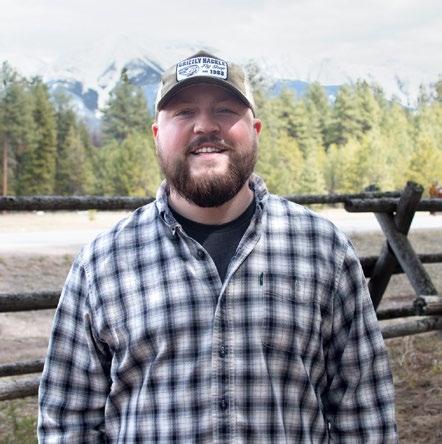
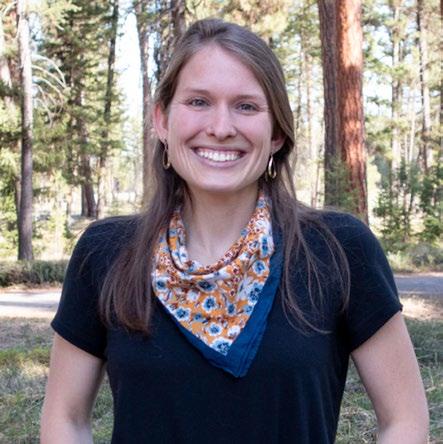
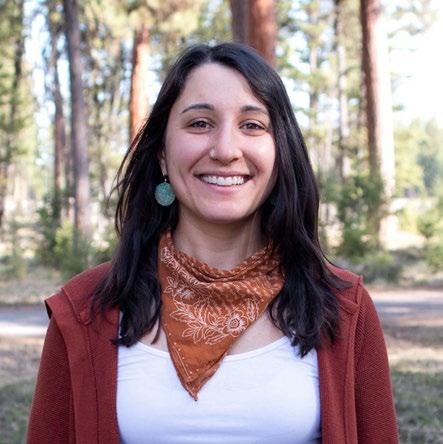
Jackie (she/her) is originally from New England, where she attained a B.S. in Wildlife Biology at the University of Vermont. She then bounced around the West following various wildlife opportunities in captive and field settings. Her travels led her to the Swan Valley, where she quickly fell in love with the area’s beauty and wildness. With extensive conservation and wildlife experience throughout the West, Jackie will help share the story of the work we and our partners are doing in the region. She is passionate about furthering her connection to the natural world, hiking, skiing, and exploring new places with her partner and two pups.
Originally from upstate New York, Taylor (she/her) grew up learning and exploring in the forests of the Northeast. Taylor has a bachelor’s degree in marine science from the University of Delaware, where she studied tidal marsh bird ecology. She first arrived in Montana in 2020 for a Yellowstone citizen science position and was drawn to stay in Montana by the community she has found here. In her free time, you can find Taylor gardening, climbing, crosscountry skiing, and exploring Montana’s forests with her partner and dog, Willa.

Rachel grew up vacationing and swimming, fishing, picking cherries and huckleberries, and visiting lookouts in and around Swan Lake, where she fell in love with this unique and wild place. She retired from the Forest Service after 34 1/2 years of service. Over the course of her career, she organized and led many public meetings and field trips, a variety of conservation education events and nature walks, prescribed fire project implementation, and formal wildlife and plant surveys. Rachel has been an active volunteer in retirement as a member of the service organization Lions Club, the organizer of the nature walk program for the Clearwater Resource Council, and a field instructor leading hiking trips in Glacier National Park with Road Scholar.
Zoë works as a Resource Forester across Montana for Pyramid Mountain Lumber, specializing in working with private landowners to achieve their ownership objectives. Utilizing the latest silviculture as well as tried and true methods of forest management, she is passionate about making forests the healthiest and most resilient they can be from the ground up. She is involved in a number of collaborative efforts and nonprofits associated with forest management in Montana.
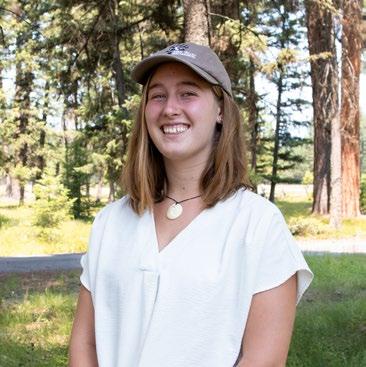
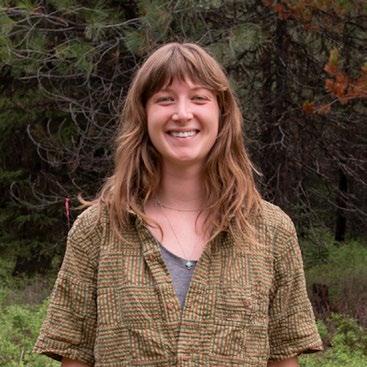
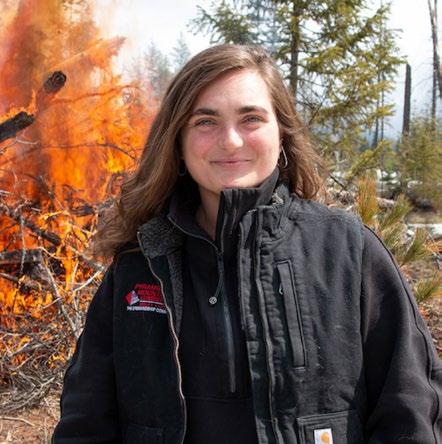
We’d also like to say thank you to our seasonal staff this summerAddie Wichman, our resident education assistant, and Kyra Parker, our conservation and visitor services assistant!
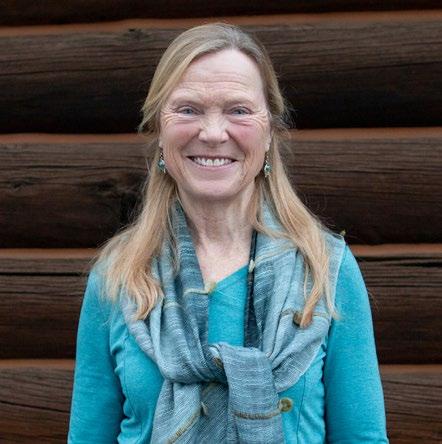
Twenty 5th graders huddled up around picnic tables shaded by towering ponderosa pines and diving cliff swallows. Many fiddled with pine needles and compared pine cone size to each other as the group settled. SVC’s Education Director, Sara Lamar, gained the group’s attention by beginning the program with the question, “What does wilderness mean to you?” Bashful sputterings from the group revealed a common theme, with answers of “outside,” “wild animals” and “camping!” To eliminate the inevitable shyness towards a new teacher, Sara asked the kids to share their name and favorite animal. Answers ranged from “mountain goat,” “ALL my dogs,” to “fluffy fat cats,” and had the students giggling and chatting over one another to share more favorites. Soon the group was reveling in excitement for the two-night camping trip ahead of them. The eagerness quickly grew as the students fidgeted in their seats and tried to stay focused during the obligatory discussion of safety protocols. The protocols covered the trusty buddy system approach, the emphasis on being extra careful (as our beautiful yet remote location in Condon is considered “the backcountry” for emergency services), and most importanthow to be bear aware while camping. The topic of bears sent a new surge of enthusiasm through the class, which grew exponentially when SVC’s Resident Education Assistant, Addie Wichman, approached the group with a giant bin of animal hides.
Sara again settled the group by steering the conversation towards the different types of common bear encounters with both grizzly and black bears, followed by tips and tricks to properly identify each species and the different
types of encounters. They went over species characteristics: claw length, shape of ears and muzzle, the grizzly “hump” between shoulders, and more. She then assigned the task of properly identifying the bear hides given out to table groups. The 5th graders made note of the long claws on a grizzly hide, and one student chimed in to say, “A bear swipe can kill you with those claws. They don’t mean to kill you, but they can. They are just scared.” Sara followed up with, “If you are the size of a grizzly bear, what do you have to be afraid of?” The students shouted out in unison, “Humans!”
All students were then given the opportunity to practice dispelling inert bear spray cans to learn how powerful this safety tool can be. Volunteers spread out with yard tape to show the rest of the class what 30 feet looks like (the recommended distance to discharge bear spray towards an approaching animal). The introduction of the camping trip was finalized by the students poking, prodding, and admiring the handful of other hides available, such as mountain lion, coyote, wolf, bobcat, and beaver, while the class discussed different physical characteristics of each species.
The group departed from the Swan Valley Community Hall, located in the heart of Condon, where all meals and food were kept, ensuring simple bear aware camping. They crossed the street and entered the Swan Legacy Forest (SLF), a 160acre parcel owned and managed by SVC, where they would be spending most of their camping trip. The kids were tasked with tent and rainfly setup and to unpack their sleeping gear. This camping trip was a first for several 5th graders, and was made even more special that the experience was shared with peers and teachers.
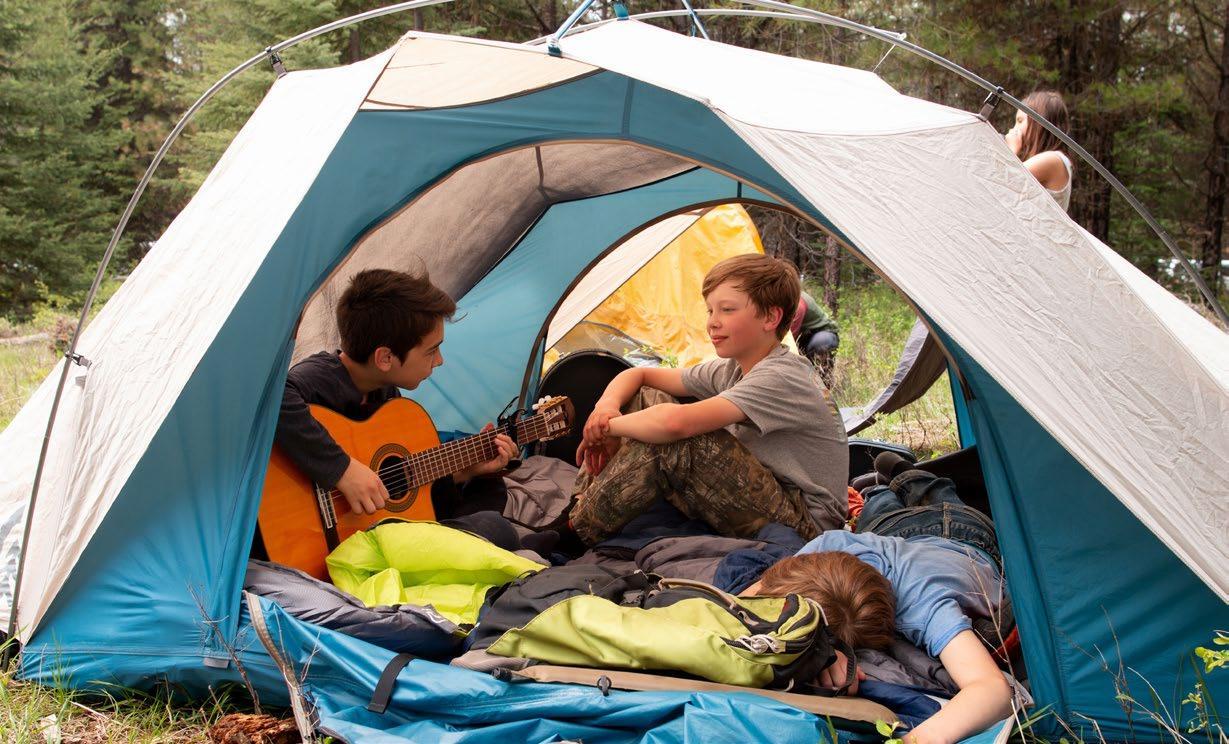
Once camp was set up, Sara told the students to “Close your eyes and go hug a tree!” (with guidance from chaperones and teachers). Interpretations were made about each tree using senses other than sight, which were then used to help the students identify their tree after gathering back together in the circle. Lessons on applied observations and interpretation demonstrated the many ways nature is experienced by individuals.
Further observation and inquiry were encouraged as Sara led a 25-person march through the heavily forested SLF property to a small wetland that sat just beyond the U.S. Forest Service boundary. She asked the students to look at the wetland and wonder why is it here? Is there a river feeding into it, or an outflow present? Is it formed through groundwater upwelling? Rainwater accumulation? Upon arrival it took mere moments for half of the class to charge into the wetland, waist-deep in murky water, with giant nets in hand and even bigger grins. Nothing quite like a bit of mud to motivate a bunch of kids to participate in a school lesson.

As the brave wetland warriors caught nets full of giant water bugs, salamander larvae, garter snakes, and predaceous diving beetles, the students who chose to stay out of the water were examining the specimens in clear plastic cups and a big tub filled with water. Others were running back and forth to the group to show their prized spider or other small critter. Sara taught the students how best to hold a snake (by supporting the head and body), how to protect the larvae (by keeping them separate from the predaceous beetles), and explained how long these animals could tolerate observation before they should release them back to their homes. The pure fascination (and in some cases, revulsion) to the plethora of aquatic reptiles, amphibians, and insects that were found in a small wetland was infectious. And just think –the Swan Valley has over 4,000 wetlands within our watershed- that’s a lot of little critters!
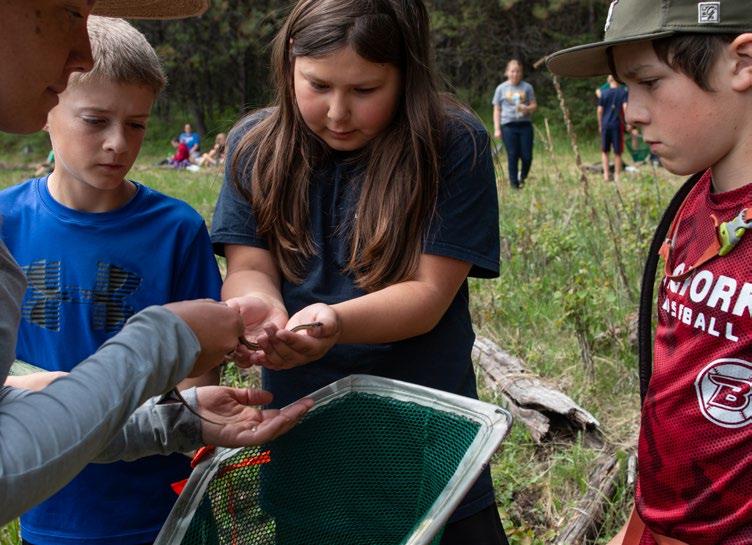
The day wound down back at the community hall, where parents and chaperones prepared dinner as the students played on the basketball court and jungle gym. The night was filled with hearty camp food, a cozy campfire, and campfire stories– the essentials.
Day two started off with nature games and a personal nature journal exercise, where everyone could reflect on their surroundings. The students were asked to identify five things they could see, four things they could hear, three things they could feel, two things they had learned, and one thing they knew. This reflective time was followed up by some good-ole-fashioned shelter building, where
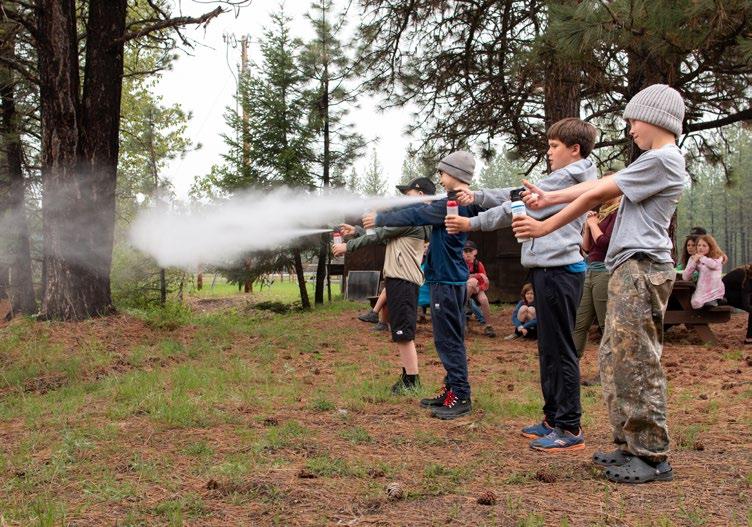
everyone’s creativity was displayed through their ideas on what a proper shelter was. All the while, excitement and anticipation were brewing for the animal encounter to happen later that day with Animal Wonders, a wildlife rescue and traveling education center based in Potomac, Montana.
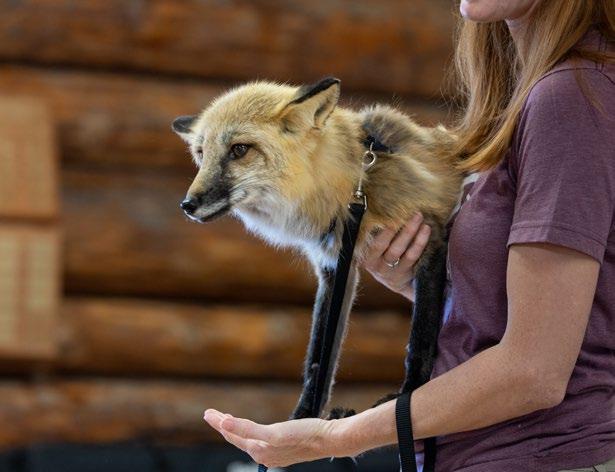
The time finally came where students were shuffled into the community hall, asked to sit crisscross-applesauce, and gather their enthusiasm into nothing more than a peep , so Executive Director and Co-Founder of Animal Wonders, Jessi Knudsen Castañeda, could bring her animal ambassadors out for the students to meet and learn about! Jessi taught the class about the important ecological roles that her animal friends have on our Montana ecosystems. She dove deep into ageappropriate ecology and life history of her ambassador animals, including Huckleberry the beaver, Seraphina the red fox, Taffy the rubber boa, and Slick the tiger salamander.
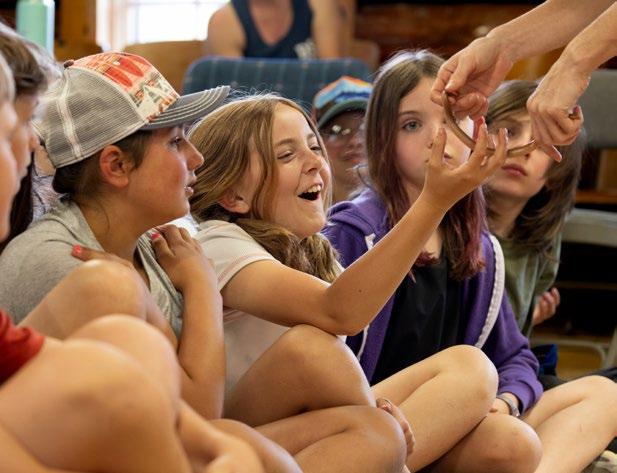
The kids squealed with excitement at Huckleberry’s reveal, and gasped in amazement as Jessi explained the life history of her amphibian and reptile friends. She explained that her rubber boa, Taffy, does not strike the way that most snakes do. Jessi then asked the students, “If rubber boas don’t strike, then what’s something they can eat that can’t run away?” She was quickly answered with “Leftovers!” from an animated student, which awarded everyone a good laugh. At the end of her visit Jessi allowed the students to gently hold Slim, while she taught them about amphibian skin. Amphibians breathe through pores in their skin, so the oils on our hands can clog their pores and inhibit their ability to breathe. She shared that it is okay to pick up salamanders and other amphibians, but to
remember to make sure your hands are wet to protect their unique skin layers!
Day two wrapped up in similar fashion, with parents and teachers preparing meals and kids playing outside. More stories were shared over a roaring fire and reflections were made. The following morning was greeted with a closing ceremony and remarks from the students before they headed north back to Bigfork. The teachers shared with Sara their gratitude for the opportunity for all three 5th grade classes to experience this camping trip, as it was a tradition for years prior to the pandemic. As these students grow up, graduate, and go on to high school, many of them revel at the memories made and friendships forged during their Bigfork Elementary 5th grade camping trip!
Swan Valley Connections was honored to kick off our summer season by hosting the Bigfork Elementary 5th graders, and to play a part in the spark of admiration and curiosity that kids have for the natural world.
“In the end we will conserve only what we love, we will love only what we understand, and we will understand only what we are taught.”
– Baba Dioum, 1986Jessi wraps Taffy, the rubber boa, around a fifth grader’s fingers, so they can feel her smooth scales. Jessi holds Seraphina, a 12-year-old red fox, who was rescued from a fur farm. Previous two pages: Fifth graders at camp after setting up their tents, practicing bear spray outside of the Swan Valley Community Hall, and exploring all of the reptiles, amphibians, and bugs at the wetland.
In the book Ishmael by Daniel Quinn, a man distraught by the ways of the world seeks comfort in a teacher. He answers a newspaper ad of someone offering to teach why things are the way they are. The teacher talks about the history of human evolution, growth, learning, and consumption of resources.
He asks one crucial question: ‘With man gone, will there be hope for gorilla?’
This question is open for interpretation. Do you see this question as a hopeful future for the gorilla, that once man has disappeared from the earth, he can flourish and thrive? Do you see this question as an ominous premonition, that once man is gone, nothing else can survive? The only certainty this question provides is that man and gorilla are intrinsically intertwined, and one without the other will disrupt the natural order of things. The question also asks, is one better than the other? Why does the fate of the gorilla rest entirely on the shoulders of man, like he is somehow more capable?
Humanity is afraid and desperate for control. We push our riverbanks away from fields because we fear our wheat drowning. We irrigated water from the rivers to the plains because we fear being thirsty. We slaughter predators for killing because we fear being killed. We cut trees en masse to feed our fires and cover our heads. We have shaped our entire world to cater to our needs and asserted dominion over the Earth. Humans are undeniably the champions, but as we continue to mold and contort our landscape, we find that control is slipping from our fingers. The rivers we’ve moved are running faster and cutting deeper into the ground, the water we’ve channeled is muddied by the cattle we’ve wrangled and kept. The animals we’ve killed leave gaps in the balance of the ecosystem, and their absence causes things to collapse. The trees we’ve burned fill the air with smoke, and everything is heating up. Despite this, I believe humanity has inherent value with our presence on the landscape.
When we talk about conservation, there is an underlying heartbeat of our responsibility to the environment, and what we owe it. Now that we’ve moved the rivers, is it our responsibility to move them back? Do we need to control the populations of the animals we’ve affected, or is it natural selection? Should we replant the forests we cut, or is it just a new landscape?
Or is our need for control just manifesting in new ways?
Through my experiences in this course, I believe that we do have a responsibility to restore and protect the lands we have affected, but it is important to remember that we never have full control. The landscape will never look how it did before, and as we restore and conserve what we have, we need to keep in mind that we are participants, not owners...If citizens can accept the natural ebbs and flows of wildlife populations, are willing to adjust their ways to be accommodating of the returning of predators, and can adopt a mindset of cooperation with the environment, then everything else will follow suit. American culture is incredibly individualist and non-cooperative, and while it is difficult to change the perception an entire nation of people have towards their wildlife, there are already changes happening in communities across the country.
 Excerpts from final reflection by Iris Smith, Wildlife in the West ‘23 alum
Perhaps with man the gorilla has no hope, or perhaps no hope without. Or maybe the relationship between humankind and our environment is not as black and white, as hopeful or hopeless.
Excerpts from final reflection by Iris Smith, Wildlife in the West ‘23 alum
Perhaps with man the gorilla has no hope, or perhaps no hope without. Or maybe the relationship between humankind and our environment is not as black and white, as hopeful or hopeless.
Bri Dostie is an artist, educator, and entrepreneur, freelance writer and illustrator, founder of Confluence Collective, and lover of nature. Bri grew up in rural Maine and currently resides in Missoula with her partner. When not facilitating community outdoor experiences, you can often find her foraging for mushrooms, listening for birds, wading in a river, or creating art inspired by nature. Bri’s art dissects themes of identity, socialized cultural norms, queerness, and interconnected existence between humans and our wild surroundings. Her work is reflective and detailed, often exploring narratives of relationship through dynamic composition and surreal interactions between subjects.
CAN YOU DESCRIBE THE CREATIVE PRACTICE(S) YOU USE TO EXPLORE THE NATURAL WORLD?
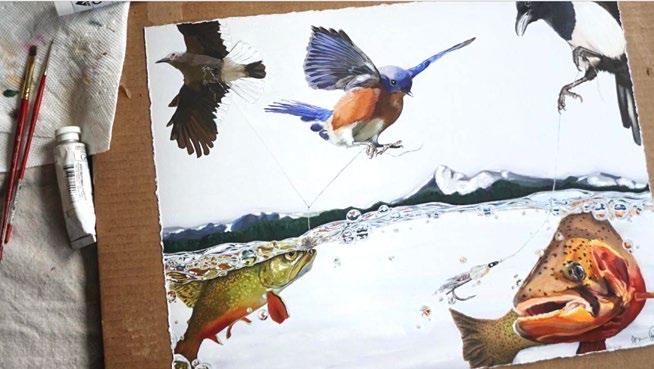
Being curious and intentional in my movements outside inform my detailed and interconnected creative representations of nature. By taking time to notice and be deeply enamored or intrigued by the little details of an ecological space, I find reasons to celebrate further through creation. Often my practice is informed by many interactions in nature, over time, developing a sense of knowing with the species represented and the worlds they inhabit as humbly and honestly as I can. There’s no prescriptive process in terms of gathering referential materials or perfecting representation; I’ve given in more to the feelings of the space, and the ways of being established over time between myself and any beings incorporated. They become reasons to dive deeper on very human themes, challenges, and relationships. And artistic practice becomes a way to do the work of healing, knowing, celebrating, and being.
CAN YOU SHARE AN EXAMPLE OF HOW A PARTICULAR LANDSCAPE, SPECIES, OR ECOLOGICAL RELATIONSHIP HAS INSPIRED YOUR CREATIVE PRACTICE OR SHAPED YOUR PERSPECTIVE?
Water-based worlds and aquatic ecosystems tend to be the spaces I gravitate towards, as they also tend to be places of immense biodiversity, change, seasonal shifts, and inherent
fluidity. I think in my body, my emotions have felt very big, and I’ve struggled to name many with any sense of gut feeling until I give in to the tumult and flow. I’ve craved spaces that normalize expansive existence, and found glimpses of what I’ve needed to identify in myself in ways I can accept the message, surrounded by a natural space that flourishes holding the same truths I may avoid elsewhere.
Going to a river or tidal estuary allows my ebbs and flows to exist without apology; they encourage an acceptance of movement, change, growth, and cyclical being. While the water is always new to step into, reminders of consistency remain: the same stonefly nymphs will cling to their rocks for years before transforming for a hatch, the same hen goldeneye will return to nest a new clutch of eggs and rest in the sunshine of the same rock from summer to summer. Coming back to self makes sense in these places.
CAN YOU DESCRIBE A PARTICULAR CREATIVE EFFORT THAT YOU ARE PROUD OF?
I think I struggle feeling prideful about my creations, knowing no matter of celebration I can accomplish is even close to the gratitude the natural spaces that inspire them are worthy of. With that said, I am grateful for the opportunities to spend

time on smaller things I may have walked over in the past, or been distracted from by some brighter or more gregarious feature. And I do feel honored to represent someone else’s relationship with any accuracy for their relationship with place; that kind of shared intimacy in understanding is truly special.
I think for that reason I am particularly attached to commissioned work, like the one included in this newsletter, and a series of bird and fish interactions placed between Maine and Montana. These are pieces I know were received with a familiarity of knowing, kind of like we could share a hug by coming together to make something, celebrating a natural space and its inhabitants we both love. I also love my series of warblers with flies from western Maine, as they’re a kind of well-deserved love note to changemaking women of the past who paved the way for me to be on the same riverbanks.
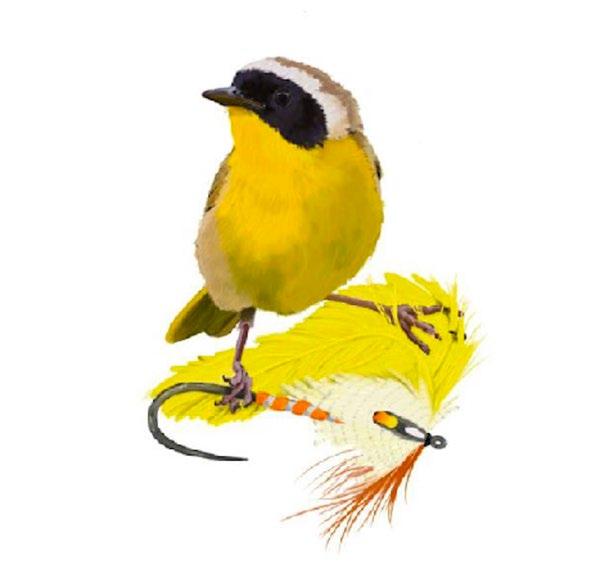
I think people investing the time, energy, and loving space for themselves to find their own way of observing, noticing, appreciating, and reconnecting to natural spaces — whatever form that needs to take for the practice to be accessible to them — is a huge win for conserving and stewardship.
For me, as a kid, drawing was a way for me to at once escape the human-built spaces I didn’t know/felt constrained and misunderstood within, and honor the gravitation I felt to soothe self amongst the undergrowth and mixed deciduous/ coniferous canopies. It was an excuse to spend more time flipping logs and listening to birds.
Not only did drawing allow me to get to know the inhabitants of the woods better, it helped me find the loving spaces I needed — and name them — to prioritize my own health and wellbeing. Spending time outside left room for all the emotion without fear of suffocation, gave air to the not knowing, the curiosity without clear answers, and messiness that is existing as human...to BE. As a result, I do all I can to ensure access to these spaces for others, in a society that desperately needs connection and interruption to engrained patterns of what others think our one precious human existence should be.
I’ve grown familiar with certain ecosystems, and recognize changes and shifts due to warming climates and human pressures, and with the clarity of mind I gain from spending time there, I find the words and ways to bring back to my communities and demand protection. My creative practice also keeps reminding me to stay sustainable in my work by maintaining the time, energy, and space to find myself back amongst the trees and rivers on a regular basis. I doubt I’ll ever have a singular balance to recommend, but I do know access to natural spaces is the only way to keep working towards one, and to ensure access, we need to ensure natural spaces remain intact beyond our lifetimes.
I cannot express the excitement I have for the Artist Wilderness Connection upcoming in August. I spent most of my outdoor time in my life in the Maine woods, and have been continually pulled west to access different ways of being informed by the natural world. Being able to spend every moment for two weeks on the same riverbank with very minimized human-world distraction is tapping into some energy I’ve had buried for a long time, with tinges of fear and glee and anticipatory buzzing.
I’ve found parts of self out here that I don’t think I could have back east, just given the compounded complexity of relational connections, points of access, and cultural expectations. And with each year of life proving more humbling than the last, I know the freshness of connection for me in a place like the Bob Marshall Wilderness will hold lots of growth, hopefully some healing, and reconnection to embodied self that I’ve needed for a long time, in ways I can’t pretend to expect. With so many predictive planning and scheming in our world, how rare is it to have time set aside with ambiguous notions of what it might hold? And to have this chance of building back confidence in self by practicing the skills I’ve had and used all-too-infrequently, even as a guide for others for many years — to do so with only my agenda and self-declared intentions for greater community and collaborators? Wild.
I’ve been scheming creative work around socialized femininity and politicized existence in queerness, particularly unpacking the influences and impacts of fear on the individual, and looking deeper to joy and rest and curious creation seems like a gentle way of exploring further. These human-as-partof-nature dynamics are taught to be so foreign to so many; reveling in the naturalness of it all feels important to do with an opportunity like this.

It seems out of place in the nighttime forest: a bright white bedsheet, held up by metal poles, glowing with the twin intensity of a blacklight and a mercury vapor bulb. And already, this outlandish object is drawing in moths.


The late May air is damp with recent rain. A Swainson’s thrush sings sleepily from the shadowy ponderosa pines around us. We’re in Condon, Montana, a stone’s throw from the Swan Valley Connections office, kicking off SVC’s Master Naturalist Rendezvous weekend with a moth evening. Mat Seidensticker, an owl biologist turned moth expert, is giving us a snapshot of the work he does with the Montana Moth Project.
“The diversity is amazing, and some of them are just as boldly patterned as butterflies,” he tells us.
Mat points out an American lappet moth (Phyllodesma americana) as it lands on the sheet. Its forewings are painted in a subtle palette of lavender, chestnut, and slate, the leading edges bizarrely ruffled to resemble fallen leaves.
We spot a wandering tiger moth (Spilosoma vagans): a creature the color of cornbread with an incredibly furry thorax. Several moths in the genus Pero have arrived, ashy-gray animals the shape of stealth fighters with a bold stripe of charcoal across their wings. Some of us are surprised to learn that the moths in this family (Geometridae) are the adults of the familiar inchworm caterpillars.
In another week or two, common nighthawks will be returning to the Swan Valley, cruising through the evening air in search of dinner. Mat calls them “the whales of the sky”—one species among the many that thrive on nighttime skies full of moths. Flammulated owls, bats, grizzly bears: the list of animals that depends on moths goes on and on.
And like all of the living beings around us, each of these moths does more than just one thing. Many have developed specialized relationships with particular plants. Mat explains
that moths have a “double link” with plants, feeding on the vegetation around them as larvae and then carrying pollen as adults. Moths can transport pollen vast distances—in some cases, hundreds of kilometers—linking the reproduction of farflung plant populations. In the Bitterroot Valley, Mat has even found an inchworm moth carrying orchid pollen. Fed by plants, facilitating pollination, and fed on by grizzlies: moths tie the forest together.
How many moths are there in Montana? So far, the Montana Moth Project has identified around 1100 species. But at the end of the evening, as he’s packing up, Mat casually mentions that by the time all of the micro-moths have been identified, he wouldn’t be surprised if Montana’s true moth diversity is between 4000 and 5000 species.
The Master Naturalist weekend is about more than just moths, of course. And as the presentations and field forays progress, the complexity and interconnectedness of the world around us comes even more crisply into focus.

Beth Mendelsohn, with Owl Research Institute, brings us into the lives of Montana’s 15 owl species, telling us about their habitat needs and their ecology. Although raptors like owls tend to be uncommon, in some amazing cases they can actually nest side by side.
“We’ve had a single tree with a great horned and a pygmy-owl nest,” she tells us.
She shows us how to look for the small owls that nest in tree cavities—including the moth-eating flammulated owl— and reminds us that voles are essential in the diets of many owl species.
On a tracking foray with SVC Conservation Director Luke Lamar in a soaking afternoon rain shower, we find not only grizzly bear and wolf tracks, but also the winter scat accumulations left by voles. Based on the habitat, a mature mixed forest with plenty of downed woody debris, Luke suspects that this sign is from the southern red-backed vole (Clethrionomys gapperi). These rodents not only feed owls, but they also eat lots of fungi, dispersing spores around the forest.
And on a field trip with University of Montana researcher Tim Wheeler, we take a deep dive into the fungal universe. We learn about the richly threaded complexity of mycelium that courses through the nutrient-rich humus under our feet. Mycorrhizal fungi connect trees with the soil and with each other—and sometimes give us tasty treats, such as the yellow coral mushrooms (Ramaria sp.) that we find growing under a subalpine fir. We learn about saprophytic fungi, or fungi that feed on dead plant and animal remains, as Tim points out species that specialize on fallen pine needles and dead huckleberry leaves. And we find the underground fruit of a false truffle (Rhizopogon ochraceorubens), a fungus the size and smell of a new potato. Across the forest, the red squirrels have been busy harvesting these false truffles.
It’s all connected. And by spending a weekend learning
about it, we’re strengthening our personal ties with the diversity of life around us, and with each other.
On Sunday afternoon, we’re searching the edges of a pond with Matt Bell, an amphibian and bat expert working with Montana Land Reliance, looking for Columbia spotted frogs and other amphibians, when we find yet another unexpected surprise. It’s a massive predaceous diving beetle (family Dytiscidae), its glossy black carapace, or hard upper shell, edged with yellow. The beetle scrabbles frantically as we get photos, paddling the air with its six sleek legs. Then we release it into the shallows, and it slips gracefully away.

We went out looking for moths, only to find them connected to orchids, owls, and grizzly bears. When we looked for owls, we found that many of them depend on voles; the voles, in turn, are linked with fungi. And when we went out to check on our local amphibians, we found not only spotted frogs but also diving beetles.
The tapestry of nature around us is infinite, complex, tightly woven—and fun. And to spend the weekend with an amazing group of naturalists, learning from each other and deepening our connection with the abundant life around us: I couldn’t think of a better place to be.
Maybe I’ll see you out there next year.
Our annual fundraiser, Summer Soirée in the Swan, is fast approaching, and we’ve got the same goal as last year: to raise money for our experiential education scholarship fund. We wanted to share some numbers to highlight the impact of your donations and generosity from the past year! There are still tickets available at www.swanvalleyconnections.org/events, but if you’re unable to join us in person this year, we hope you’ll still participate in our online auction or make a gift to the fund.
16 scholarship recipients
$19,350 scholarship dollars awarded


6 programs supported
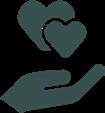

CAROL GE, wildlife tracks & sign
I’m an international student from China. This winter wildlife track & sign course was really a life-changing experience for me, and there are so many significant and memorable moments. I still remember my excitement when we backtracked a wolf pack and found their kill site. This experience made me start to think about nature in a different way...for the very first time, I allowed myself to slow down and really pay attention to all the marks animals left behind. Every animal leaves traces in nature that tell their unique stories. As humans, we are part of the nature, and there are endless things we can learn from it.

Through my schooling and years in the field of natural resources I have learned that to be an effective manager of our environment we need to truly understand how it works first. We cannot help if we first don’t understand its natural processes and needs. I feel like this class was one more step in helping me to be an effective naturalist, which is important to me as I plan to continue working in and for our environment. I want to continue learning about animal behavior through aspects such as tracks and sign, and I am thankful for how much I was able to learn in just one week with SVC.
LISA LOCHNER, widlife tracks & sign
I was surprised and grateful when I received the news that I had been granted a scholarship. Since taking the course through Swan Valley Connections, I searched for other opportunities in different ecosystem types. The cost for all that I found was prohibitive for me, and I did not see any offers of financial aid. The fact that Swan Valley Connections offers financial assistance and generous donors provide funds allowed me, and probably some of the current college students in my group, to attend. This class was worth every penny.
JONATHAN THORSTAD , wildlife tracks & sign
They talk about all these things in the classroom, and that’s one thing, but being able to experience it in the field is a totally different thing. On top of the experience, the staff were phenomenal. They were very humble, honest, down-to-earth people who really made the trip worthwhile. This class solidified for me what I always knew - that I want to work out in the field. The tracks and sign aspect of wildlife biology is of greater value to me now. Thank you for the funds help me go on this trip. I have benefited greatly from going to Montana. I appreciate the opportunity because my passion for tracking has grown so much from this trip.
Please check our website or call (406) 754-3137 for the most up-to-date information.
July 28
Soirée Online Auction Opens!
August 2
Montana Osprey Project Community Potluck & Presentation
August 5
Upper Swan River Cleanup Volunteer Opportunity
August 12
Huckleberry Festival + Swan Valley Bear Resources Bear Fair Swan Lake
August 19-20
Weekend Warrior Master Naturalist (3 of 4)
August 20
Aspen Restoration Workshop Volunteer Opportunity

August 26
Beyond Trail Cameras Workshop
August 27
Summer Soirée in the Swan The Nest on Swan River
August 28
Soirée Online Auction Closes
September 1-4
Wildlife Field Techniques Course With Home Range Wildlife
September 22-27
6-Day Montana Master Naturalist Course

October 6
Community Firewood Day Volunteer Opportunity
6887 MT Hwy 83
Condon, MT 59826-9005

